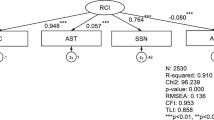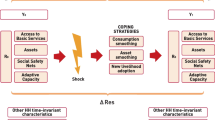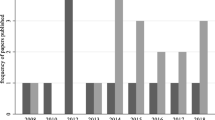Abstract
Resilience—the capacity that ensures adverse stressors and shocks do not have long-lasting adverse consequences—has become a key topic in both scholarly and policy debates. More recently some international organizations have proposed the use of resilience to analyze food and nutrition security. The objective of the paper is twofold: (i) analyze what the determinants of household resilience to food insecurity are and (ii) assess the role played by household resilience capacity on food security outcomes. The dataset employed in the analysis is a panel of three waves of household surveys recently collected in Tanzania and Uganda. First, we estimated the FAO’s Resilience Capacity Index (RCI), combining factor analysis and structural equation modeling. Then probit models were estimated to test whether the resilience is positively related to future food security outcomes and recovery capacity after a shock occurs. In both countries, the most important dimension contributing to household resilience was adaptive capacity, which in turn depended on the level of education and on the proportion of income earners to total household members. Furthermore, household resilience was significantly and positively related to future household food security status. Finally, households featuring a higher resilience capacity index were better equipped to absorb and adapt to shocks.

Similar content being viewed by others
Notes
The Technical Working Group on Resilience Measurement is a group of experts set up in 2013 by FAO, IFPRI and WFP to secure consensus on a common analytical framework and guidelines for food and nutrition security resilience measurement, and to promote adoption of agreed principles and best practices on data collection and analysis, tools and methods.
The Min-Max scaling is based on the following formula: \( {RCI}_h^{\ast }=\frac{\left({RCI}_h-{RCI}_{min}\right)}{\left({RCI}_{max}-{RCI}_{min}\right)}\times 100 \), where h represents the hth household.
References
Alfani, F., Dabalen, A., Fisker, P., & Molini, V. (2015). Can we measure resilience? A proposed method and evidence from countries in the Sahel, World Bank Policy Research Working Paper 7170. Washington, DC: World Bank Group.
Alinovi, L., Mane, E., & Romano, D. (2008). Towards the measurement of household resilience to food insecurity: Applying a model to Palestinian household data. In R. Sibrian (Ed.), Deriving food security information from National Household Budget Surveys. Experiences, achievement, challenges (pp. 137–152). Rome: FAO Available at: ftp://ftp.fao.org/docrep/fao/011/i0430e/i0430e.pdf. Accessed 2016-06-27.
Alinovi, L., d'Errico, M., Mane, E., and Romano, D. (2010). Livelihoods strategies and household resilience to food insecurity: an empirical analysis to Kenya. Background paper to the European development report 2010, Fiesole: European University Institute.
Barrett, C., and Constas, M. A. (2014). Toward a theory of resilience for international development applications. PNAS. https://doi.org/10.1073/pnas.1320880111.
Bollen, K. A., Bauer, D. J., Christ, S. L., & Edwards, M. C. (2010). Overview of structural equation models and recent extensions. In S. Kolenikov, D. Steinley, & L. Thombs (Eds.), Statistics in the social sciences: current methodological developments (pp. 37–79). Hoboken: Wiley.
Bozzoli, C., Bruck, T., & Muhumuza, T. (2011). Does war influence individual expenctations? Economic Letters, 113, 288–291.
Carlsen, J., Hegre, H., Linke, A., & Raleigh, C. (2010). Introduing ACLED: an armed conflict location and event dataset. Journal of Peace Research, 47(5), 1–10.
Cissé J. D., & Barrett C. B. (2018). Estimating development resilience: a conditional moments-based approach. Journal of Development Economics. https://doi.org/10.1016/j.jdeveco.2018.04.002.
Constas M., Frankenberger, T. and Hoddinott, J. (2013). Resilience measurement principles:toward an agenda for measurement design. Resilience Measurement Technical Working Group. Technical Series No. 1. Rome: Food Security Information Network.
Constas M., Frankenberger, T., Hoddinott, J., Mock, N., Romano, D., Bené C. and Maxwell, D. (2014). A proposed common analytical model for resilience measurement: a general causal framework and some methodological options. Resilience Measurement Technical Working Group. Technical Series No. 2. Rome: Food Security Information Network.
d’Errico, M., and Di Giuseppe, S. (2016). A Dynamic Analysis of Resilience in Uganda. ESA Working Paper No. 16–01. Rome: FAO. Available at: http://www.fao.org/3/a-i5473e.pdf.
d’Errico, M., & Pietrelli, R. (2017). Resilience and child malnutrition in Mali. Food Security, 9(1), 1–16.
d’Errico, M., Garbero, A., and Constas, M. (2016). Quantitative analyses for resilience measurement. Guidance for constructing variables and exploring relationships among variables. Resilience measurement technical working group. Technical series no. 7. Rome: Food security information Network. Available at: http://www.fsincop.net/fileadmin/user_upload/fsin/docs/resources/FSIN_TechnicalSeries_7.pdf.
Dai, A., Trenberth, K. E., & Qian, T. (2004). A global data set of Palmer Drought Severity Index for 1870-2002: relationship with soil moisture and effects of surface warming. Journal of Hydrometeorology, 5(6), 1117–1130.
Dercon, S. (2002). Income risk, coping strategy, and safety nets. World Bank Research Observer, 17(2), 141–166.
Devereux, S., & Getu, M. (2013). Informal and formal social protection system in Sub-Saharan Africa (1st ed.). Kampala: Fountain Publisher.
EU Commission. (2012). Communication from the Commission to the European Parliament and the Council the EU Approach to Resilience: Learning from Food Security Crises. Brussels, 3.10.2012, COM(2012) 586 final.
FAO (2015). The state of food insecurity in the world 2015. Meeting the 2015 international hunger targets: taking stock of uneven progress. Rome: FAO, IFAD and WFP.
FAO (2016a). Resilience index measurement and analysis (RIMA). Rome: FAO. Available at http://www.fao.org/resilience/background/tools/rima/en/. Accessed Nov 13th 2016.
FAO. (2016b). Resilience index measurement and analysis (RIMA – II). Rome: FAO Available at http://www.fao.org/3/a-i5665e.pdf.
FAO, UNICEF, WFP. (2012). A Joint Strategy on Resilience for Somalia, Brief, July 2012. http://www.fao.org/fileadmin/templates/cfs_high_level_forum/documents/Brief-Resilience-_JointStrat_-_Final_Draft.pdf.
Folke, C. (2006). Resilience: the emergence of a perspective for social-ecological systems analyses. Global Environmental Change, 16(3), 253–267.
Frankenberger, T., Spangler, T., Nelson, S. and Langworthy, M. (2012). Enhancing resilience to food security shocks in Africa Discussion Paper. Available at www.fsnnetwork.org/sites/default/files/discussion_paper_usaid_dfid_ wb_nov._8_2012.pdf.
Gallopin, G. (2006). Linkagers between vulnerability, resilience, and adaptive capacity. Global Environmental Change, 16, 293–303.
Gunderson, L. H., Holling, C. S., Peterson, G., and Pritchard, L. (1997). Resilience in ecosystems, institutions and societies. Beijer Discussion Paper Number 92, Stockholm: Beijer International Institute for Ecological Economics.
Hoddinott, J. (2014). Looking at development through a resilience lens. In Resilience for food and nutrition security (pp. 19–26). Washington, D.C.: International Food Policy Re-search Institute (IFPRI).
Holling, C. S. (1996). Engineering resilience versus ecological resilience. In P. C. Schulze (Ed.), Engineering within ecological constraints (pp. 31–44). Washington, D.C.: National Academy Press.
Pangaribowo, E. H., Gerber, N., and Torero, M. (2013). Food and nutrition security indicators: a review. FOODSECURE Working paper 05.
Smith, L. C., & Frankenberger, T. R. (2018). Does resilience capacity reduce the negative impact of shocks on household food security? Evidence from the 2014 floods in Northern Bangladesh. World Development. https://doi.org/10.1016/j.worlddev.2017.07.003.
Smith, L., Frankenberger, T., Langworthy, B., Martin, S., Spangler, T., Nelson, S. & Downen, J. (2014). Ethiopia Pastoralist Areas Resilience Improvement and Market Expansion (PRIME) Project Impact Evaluation: Baseline Survey Report. Rockville: Feed the Future FEEDBACK project report for USAID.
Vaitla, B., Tesfay, G., Rounseville, M. and Maxwell, D. (2012). Resilience and livelihoods change in Tigray, Ethiopia. Feinstein International Center, Tufts University. October 2012.
Vermote, E., Justice, C., Csiszar, I., Eidenshink, J., Myneni, R., Baret, F. M., Wolfe R., Claverie M. and NOAA CDR Program (2014): NOAA Climate Data Record (CDR) of Normalized Difference Vegetation Index (NDVI), Version 4 [1982–2014]. NOAA National Climatic Data Center. doi, 10, V5PZ56R6.
Winters, P., Davis, B., Carletto, G., Covarrubias, K., Quiñones, Zezza, A., Azzarri, C., & Stamoulis, K. (2009). Assets, activities and rural income generation: evidence from a multicountry analysis. World Development, 37(9), 1435–1452.
Zseleczky, L., & Yosef, S. (2014). Are shocks really increasing? A selective review of the global frequency, severity, scope, and impact of five types of shocks. In S. Fan, R. Pandya-Lorch, & S. Yosef (Eds.), Resilience for food and nutrition security (pp. 9–17). Washingtn D.C.: IFPRI.
Acknowledgements
The authors acknowledge collaboration with the International Food Policy Research Institute for the creation of the climatic dataset employed in the paper. They also thank the participants of the 5th Italian Association of Agricultural and Applied Economics (AIEAA) Congress (University of Bologna, June 16-17, 2016) and the 90th Annual Conference of the Agricultural Economics Society (Warwick University, April 16–17, 2016) for the stimulating discussion on the Working paper version of this paper. The authors also thank the editor and two anonymous referees for very helpful comments that significantly contributed to improving the final version of the paper.
Author information
Authors and Affiliations
Corresponding author
Ethics declarations
The views expressed in this article do not necessarily reflect the views of the Food and Agriculture Organization of the United Nation.
Conflict of interest
The authors declare that they have no conflict of interest.
Appendix
Appendix
Rights and permissions
About this article
Cite this article
d’Errico, M., Romano, D. & Pietrelli, R. Household resilience to food insecurity: evidence from Tanzania and Uganda. Food Sec. 10, 1033–1054 (2018). https://doi.org/10.1007/s12571-018-0820-5
Received:
Accepted:
Published:
Issue Date:
DOI: https://doi.org/10.1007/s12571-018-0820-5




